
Original Link: https://www.anandtech.com/show/1090
Gigabyte 7VAXP-A Ultra: The KT400A in Retail Action
by Evan Lieb on March 31, 2003 3:19 AM EST- Posted in
- Motherboards
Today we bring you one of the first reviews of a retail KT400A motherboard. Gigabyte was able to send us their KT400A motherboard before any other manufacturers, and best of all in total working order. The only other KT400A motherboard we've received has been from Soltek; you'll see a review of this board in the near future.

In case you're interested in the exact differences between VIA's KT400 and KT400A chipset, read our KT400A preview from a couple weeks ago for detailed information on this chipset. Bear in mind that the KT400A performance results in that review are of a reference KT400A motherboard, whereas this review's KT400A performance results are of a retail motherboard from Gigabyte, dubbed the 7VAXP-A Ultra.
Read on to see how Gigabyte's KT400A motherboard fares against the fastest Athlon XP motherboards based on NVIDIA's nForce2 chipset…
Gigabyte 7VAXP-A Ultra Revision 1.0: Basic Features
|
Motherboard Specifications |
|
|
CPU
Interface
|
Socket-462
|
|
Chipset
|
VIA
KT400A North Bridge (CD Stepping)
VIA VT8235 South Bridge (CD Stepping) |
|
Bus
Speeds
|
up
to 250MHz (in 1MHz increments)
|
|
Core
Voltages Supported
|
up
to 1.815V (in 2.5%/5% increments)
|
|
I/O
Voltages Supported
|
N/A
|
|
DRAM
Voltages Supported
|
up
to 2.8V in 0.1V increments
|
|
Memory
Slots
|
3
184-pin DDR DIMM Slots
|
|
Expansion
Slots
|
1
AGP 8X Slot
5 PCI Slots |
|
Onboard
RAID
|
Promise
PDC20276
|
|
Onboard
USB 2.0/IEEE-1394
|
USB2
Supported through South Bridge
VIA VT6306 IEEE-1394 Firewire Controller |
|
Onboard
LAN
|
Realtek
8100BL
|
|
Onboard
Audio
|
Realtek
ALC650 6-channel audio
|
|
Onboard
Serial ATA
|
Silicon
Image SI3112A
|
|
BIOS
Revision Tested
|
MG2
(03/14/2003)
|
Let's first start out by taking a look at the onboard LAN controller that is integrated on the PCB of the 7VAXP-A Ultra. The LAN controller is by Realtek, dubbed the RTL8100BL controller. This 10/100 LAN controller can be found on several high-end motherboards.
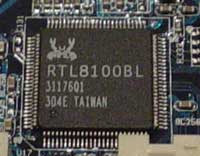 |
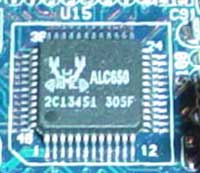 |
The onboard sound is powered by Realtek's ALC650 chip. This is in contrast to the VT1616 that VIA has been touting since the KT400A was launched a couple weeks ago. With Gigabyte using the ALC650 instead of the VT1616, VIA's claim to fame with the VT1616 doesn't apply, and any edge over MCP-T nForce2 motherboards is lost, even despite the fact that all nForce2 motherboards use Realtek's ALC650. We should also remind you that neither the VT8235 South Bridge (which will ship with the 7VAXP-A Ultra) nor the VT8237 South Bridge (which will ship with later versions of the 7VAXP-A Ultra in April/May) have dedicated DSP logic, whereas the nForce2 APU does.
The 7VAXP-A Ultra's I/O configuration includes two PS/2 ports, two serial ports, one parallel port, two rear USB 2.0 ports, one LAN port, a Game port, and three 1/8' jacks, which are driven by the onboard sound. Most users won't have any complaints about this configuration, though integrated SPDIF and FireWire ports would have been an excellent addition for a high-end mainboard like the 7VAXP-A Ultra.
The 7VAXP-A Ultra brings some excellent IDE support to the table. Firstly, the Primary and Secondary IDE connectors support two channels each, or up to four IDE drives in total (this includes ATAPI devices and hard drives).
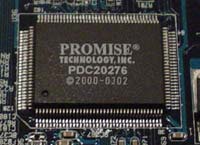
The IDE RAID PDC20276 controller powers the third and forth IDE connectors present on the PCB. Both the third and forth IDE connector support two channels each, or up to four IDE drives; this is exactly how the Primary and Secondary IDE connectors work, expect that the PDC20276 controller doesn't allow the third and forth IDE connectors to support ATAPI devices (e.g. CD/DVD ROM drives), only hard drives. This is a common limitation of IDE RAID controllers, though it shouldn't be too much of an issue if you don't need more than four optical drives in your system.
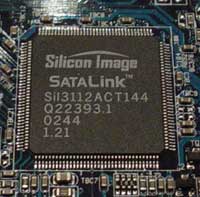
The Gigabyte 7VAXP-A Ultra uses Silicon Image's SI3112A Serial ATA controller as well. The 3112A controller is capable of supporting up to two independent Serial ATA devices as well as RAID 0 (striping) and RAID 1 (mirroring). Although Serial ATA drives have yet to hit the market in any sort of reasonable quantities, this board will have you ready for the transition as it ships with two Serial ATA cables. Unfortunately Gigabyte won't be shipping their 7VAXP-A Ultra with VIA's VT8237 South Bridge, which natively supports the Serial ATA150 standard. Having native Serial ATA support via the VT8237's own I/O link would free the 133MB/s-constranined PCI bus for other devices.
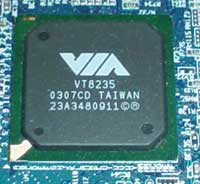
Now standard on all VIA chipset-based motherboards, the VT8235 South Bridge supports USB 2.0 technology like any other modern-day South Bridge. In total you can activate up to six USB 2.0 ports; two via the rear I/O ports and four via onboard USB 2.0 headers. Thankfully Gigabyte includes a four-port USB 2.0 bracket with all the rest of the 7VAXP-A Ultra's accessories. This will save you a little time and a few extra dollars if you were forced to purchase a USB 2.0 bracket.
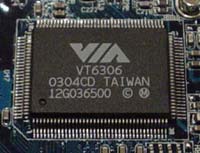
Another nice addition to the 7VAXP-A Ultra is FireWire. Gigabyte chooses the VT6306 FireWire controller to power the three available FireWire headers onboard the 7VAXP-A Ultra. So in total, you will be able to use three FireWire ports. However, Gigabyte only bundled a single-port FireWire bracket with the 7VAXP-A Ultra, which means you'll be two FireWire ports short of your potential. Hopefully Gigabyte will change this once they start shipping 7VAXP-A Ultra motherboards in April.
Gigabyte 7VAXP-A Ultra: Board Layout
The 7VAXP-A Ultra has a somewhat unique layout compared to the latest high-end motherboards on the market. Let's get started….
First off, the ATX (20-pin) connector is right where we like it, on the right-hand side of the motherboard above the Primary and Secondary IDE connectors. We continue to praise this type of positioning because thick ATX wires can obstruct the installation/uninstallation of the CPU HSF in addition to any other components that might be modified around that area. One of those areas are where the mounting holes should have been, but that Gigabyte decided to opt against. Users looking to install higher quality MCX and PAL heatsinks will be disappointed with the 7VAXP-A Ultra, but there's always other screwless options like the Volcano 7+ series of heatsinks with fan-control and copper construction that attaches directly to the CPU socket.
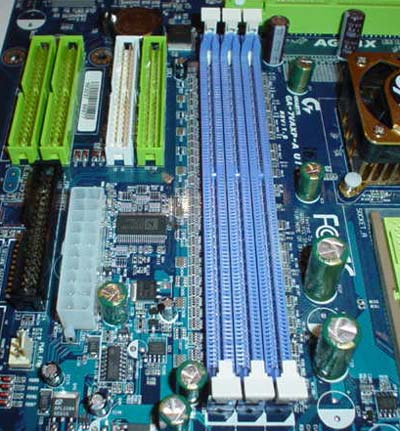
The Primary and Secondary IDE connectors are positioned exactly where we like them; above the AGP slot and to the right. This time though Gigabyte pushes the Primary and Secondary IDE connectors a bit further towards the middle of the PCB, and this is where it gets a bit messy. If you use both or one of the Primary/Secondary connectors, your IDE cables will be colliding with the main ATX (20-pin) cable's wires, since Gigabyte pushes the Primary/Secondary connectors closer to the middle of the PCB. This can be quite a nuisance for the neat freaks out there.
The reason the Primary and Secondary IDE connectors were placed closer to the middle of the PCB was due to both IDE RAID connectors, placed about half an inch to the right of the Primary and Secondary IDE connectors. While this isn't bad in of itself, the Floppy connector complicates things quite a bit. The Floppy connector is located above the IDE RAID connectors, a couple centimeters to the right of the ATX connector. This isn't a totally ideal location if you plan on having a Floppy drive as well as a neat case; the Floppy cable will have to travel through the Primary/Secondary IDE cables and IDE RAID cables (if you've setup a RAID array of course) and then under them a bit to reach the Floppy drive bay. So while we don't like the Floppy connector location, the Primary/Secondary and RAID connectors are placed well enough so that cable length will be of no concern.
The DIMM connectors are also placed excellently. The DIMM connectors did not interfere with the long GeForce4 Ti4600 video card installed in the 7VAXP-A Ultra's AGP slot. This is nice to see as you aren't forced to uninstall your video card if you need to add memory to your system. An example of a common scenario where you might need to add memory to your system while your video card is installed is when you're upgrading your system for the first time in quite a while, and you decide to add a large stick of high-speed memory to boost application performance.
There are two USB 2.0 headers and three FireWire headers located at the bottom of the 7VAXP-A Ultra, colored in yellow and grey. This is a good place to position the USB 2.0 and FireWire headers, as the wires from a USB 2.0/FireWire bracket won't collide with any other PCI cards you may or may not decide to install in your motherboard, in addition to any other components that may stick out. So in general, these locations will help to reduce clutter, which is nice.
Gigabyte 7VAXP-A Ultra: BIOS and Overclocking
The Gigabyte 7VAXP-A Ultra uses the popular Award BIOS, which most high-end motherboards use nowadays.
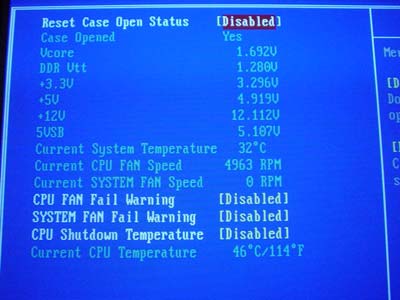
We see a pretty healthy amount of information present in the PC Health section of the 7VAXP-A Ultra BIOS. Here you'll find readings on Vcore, PSU (all rails), system temperature, CPU/System fan speed, CPU temperature, and options for enabling or disabling CPU/System Fan Failure Warning, CPU Shutdown Temperature, and Case Open Status options. We would have like to have seen an RPM reading on the Power fan header, as there was one included on the 7VAXP-A Ultra above the Floppy connector. A VDIMM reading and North Bridge fan speed reading would have also been nice additions. All in all though, quite an acceptable PC Health section.
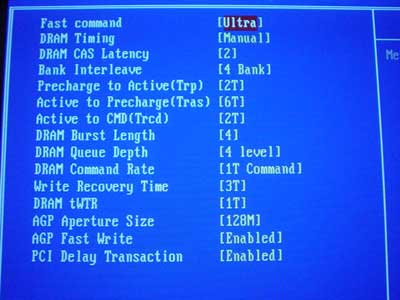
The Advanced Chipset Features section contains some pretty nice tweaking options. Some of the memory timings options available are Active to Precharge, Precharge to Active, Active to CMD, and CAS latency. A common addition among VIA chipset-based motherboards however is Bank Interleave, Command Rate, and Fast Command. Bank interleave was available up to 4-bank, Command Rate was available as low as 1T, and Fast Command was available as high as Ultra mode. It's great to see all these memory tweaking options available, especially since feature-filled nForce2 Advance Chipset Features sections starting taking the lead last year. Therefore, we feel confident in proclaiming the 7VAXP-A Ultra's Advanced Chipset Features section as one of the best we've seen from a Socket A BIOS. Just remember to hold the CTRL key while pressing F1 to open up the Advanced Chipset Features section; that's right, Gigabyte continues the CTRL + F1 tradition with the 7VAXP-A Ultra BIOS.

There are some very nice options available in the Frequency/Voltage Control section of the Frequency/Voltage Control BIOS. One of them is the high FSB adjustments, available up to 250MHz in 1MHz increments. While this gives us hope for 400MHz FSB Barton support, Gigabyte tells us that this board will not officially support 400MHz FSB Barton processors. Perhaps, though, the Gigabyte 7VAXP-A Ultra will unofficially support 400MHz FSB without issue, we'll have to get a 400MHz FSB Barton for testing to be sure.
Vcore flexibility is quite good, adjustable as high as 1.815V in 2.5% and 5.0% increments. In fact, default Vcore fluctuates a bit higher, around 1.69V with a 1.65V Thoroughbred-B processor. So in reality, you should be able to hit over 1.85V with this board if you dare go that high. If you plan on keeping your processor for any good period of time, we suggest that you not run your CPU at 1.85V.
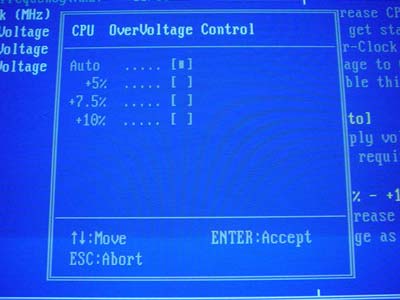
Thankfully there are a slew of CPU multiplier options in the 7VAXP-A Ultra BIOS, available from 5X to 18X. This, of course, allowed us to isolate the FSB on the 7VAXP-A Ultra to make sure the motherboard limited the FSB and not the CPU. In case you're wondering, there are onboard switches that allow adjustment of the CPU's multiplier in the BIOS just like the ones found on the previous generation Socket A VIA motherboard from Gigabyte, the 7VAXP Ultra - our review of this motherboard can be found here.
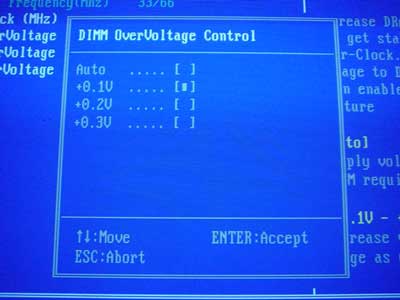
VDIMM is yet another adjustable option in the 7VAXP-A Ultra's BIOS, available up to 2.8V in 0.1V increments. This should please lots of memory overvolters, as anything over 2.8V can damage your memory in the long-term anyway.
Unfortunately there wasn't an AGP/PCI lock available in the 7VAXP-A Ultra BIOS. This is a huge loss to serious overclockers, who demand to be able to adjust their AGP and/or PCI frequencies at will. Gigabyte tells us that there is a 1/5 PCI divider, meaning you will only be able to keep your AGP and PCI buses at 66MHz and 33MHz if your FSB is running at 166MHz, but anything higher and you'll be running your AGP/PCI devices out of spec. We hope to see at least a 1/6 PCI divider soon, maybe with the KT600 chipset to be released this summer.
Here are our overclocking results using our standard overclocking setup on the Gigabyte 7VAXP-A Ultra:
|
Front Side Bus Overclocking Testbed |
|
|
Processor:
|
Athlon
XP 2400+
|
|
CPU
Vcore:
|
1.65V
|
|
Cooling:
|
AMD
Retail HSF & Thermal Pad
|
|
Power
Supply:
|
Enermax
300W
|
We this setup we were able to reach 193MHz FSB without issue. In comparison to the early nForce2 boards we've tested this is quite good. Though by now, nForce2 motherboards from ASUS, Epox, ABIT and others have been reaching 200MHZ FSB and higher on a regular basis with the latest BIOSes. So while we would have liked to have done some 200MHz FSB performance testing running at DDR400 memory speeds on the 7VAXP-A Ultra, this simply wasn't possible. Still, this is a nice overclock by almost any other standard, especially when you consider that the AGP/PCI buses were running well out of spec.
Gigabyte 7VAXP-A Ultra: Stress Testing
We were able to test this motherboard in several different areas and configurations, including:
1. Chipset and motherboard stress testing was conducted by running the FSB at 193MHz.
2. Memory stress testing was conducted by running RAM at 333MHz and 400MHz with as many modules populated as possible at the most aggressive timings possible.
Front Side Bus Stress Test Results
At 193MHz FSB we did not encounter any reliability issues with the Gigabyte 7VAXP-A Ultra. At this speed we were able to run 24 hours of Prime95 torture tests without a single failure. We reran our gaming suite (Unreal Tournament, Quake 3 Arena, Jedi Knight II) in addition to data compression and Word and Excel apps while Prime95 torture tests were running in the background. We also found some time to run SPECviewperf and XMPEG to put even more stress on the 7VAXP-A Ultra, but in the end we could not faze this motherboard.
Memory Stress Test Results
While VIA claims full support for DDR400 memory speeds with KT400A motherboards, you'll find out that this isn't exactly accurate. First, we will test the KT400A-based Gigabyte 7VAXP-A Ultra at a memory speed of 166MHz. We'll do this by installing three Corsair XMS memory modules running at 333MHz DDR. Here were the timings we were able to achieve:
|
Stable
DDR333 Timings |
|
|
Clock
Speed:
|
166MHz
|
|
Timing
Mode:
|
Ultra
|
|
CAS
Latency:
|
2
|
|
Bank
Interleave:
|
4-bank
|
|
Precharge
to Active:
|
2T
|
|
Active
to Precharge:
|
6T
|
|
Active
to CMD:
|
2T
|
|
Command
Rate:
|
1T
|
These are exactly the type of timings we love to see at DDR333 speeds. In fact, these are the lowest timings available in the 7VAXP-A Ultra's BIOS. Users that want to tweak their system to the max but don't want to overclock or anything else fancy like that will be delighted to learn that installing three memory modules running at 333MHz at these timings is hardly an issue for the 7VAXP-A Ultra. However, it doesn't get much better than this going forward…
The following chart lists the highest frequency we were able to reach at the same memory timings listed in the DDR333 stress tests above, with all memory banks occupied. Here are our results:
|
Stable
DDR400 Timings |
|
|
Clock
Speed:
|
200MHz
|
|
Timing
Mode:
|
Ultra
|
|
CAS
Latency:
|
2
|
|
Bank
Interleave:
|
Disabled
|
|
Precharge
to Active:
|
3T
|
|
Active
to Precharge:
|
6T
|
|
Active
to CMD:
|
3T
|
|
Command
Rate:
|
1T
|
We were able to operate the 7VAXP-A Ultra reliably at these timings at DDR400. Unfortunately we had to disable 4-way bank interleave and relax Precharge to Active/Active to CMD timings to 3T, all of which lowered performance a bit in a few games, but overall it's good to see that this motherboard is at least capable of 400MHz DDR memory speeds with three modules installed.
As usual, we ran several memory stress tests and general apps to make sure all these timings were stable. We started off by running Prime95 torture tests; a grand total of 24 hours of Prime95 was successfully run at the timings listed in the above charts. We also ran Sciencemark (memory tests only) and Super Pi. After all was said and done, the 7VAXP-A Ultra was able to withstand each of these memory stress tests.
Gigabyte 7VAXP-A Ultra: Tech Support and RMA
For your reference, we will repost our tech support evaluation procedure here:
The way our Tech Support evaluation works is first we anonymously email the manufacturer's tech support address(es), obviously not using our AnandTech mail server to avoid any sort of preferential treatment. Our emails (we can and will send more than one just to make sure we're not getting the staff on an "off" day) all contain fixable problems that we've had with our motherboard. We then give the manufacturer up to 72 hours to respond over business days and will report not only whether they even responded within the time allotted but also if they were successful in fixing our problems. If we do eventually receive a response after the review is published, we will go back and amend the review with the total time it took for the manufacturer to respond to our requests.
The idea here is to encourage manufacturers to improve their technical support as well as provide new criteria to base your motherboard purchasing decisions upon; with motherboards looking more and more alike every day, we have to help separate the boys from the men in as many ways as possible. As usual, we're interested in your feedback on this and other parts of our reviews so please do email us with your comments.
Gigabyte's RMA policy is easy to follow and fairly good for a tier one motherboard maker like Gigabyte:
|
Gigabyte still hasn't changed their RMA policy. Like ASUS, Gigabyte would like you to deal with the vendor you purchased your motherboard from rather than directly with them. This is understandable, as the cost of RMAs, facilities, employees, etc. can be prohibitive. Still, we would love it if the tier one guys would adopt similar RMA policies akin to Epox, Albatron or AOpen's.
Unlike the last time we reviewed a Gigabyte motherboard, Gigabyte's tech support was very timely with their response. Not only did Gigabyte get back to us within 72 hours, but they got back to us in under 24 hours; 20 hours flat to be exact. Smaller motherboard makers usually respond to tech support emails quicker than large motherboard makers like Gigabyte because the small motherboard makers simply concentrate a bit more on tech support. Then again smaller motherboard makers don't receive nearly as much tech support emails as the larger manufacturers, but that is obviously good for the consumer.
We'd like to note that when we reviewed Gigabyte's SiS 655 motherboard, they did miss our 72 hour deadline. But after publishing that article we received a response from Gigabyte 11.5 hours later. In other words, it took Gigabyte tech support 83.5 hours to respond to our email in February. This month it took just 20 hours. Though that might seem slightly inconsistent, it's easily forgivable, and we're actually quite delighted with that pattern. Though Gigabyte has missed a couple 72 hour deadlines in previous reviews, only once did they not respond to our emails in a reasonable amount of time after the two instances that they missed our 72 hour deadline (83.5 hours is certainly forgivable, whereas there was one instance last year where Gigabyte ended up missing the 72 hour deadline by well more than just 11.5 hours).
Though Gigabyte's RMA policy is just adequate, their tech support response time is good and getting much better, especially this time around.
Performance Test Configuration
|
Performance Test Configuration |
||
| Processor(s): |
AMD Athlon
XP 2700+ (333MHz FSB)
|
|
| RAM: |
2 x 256MB Corsair PC3200 TwinX Modules
1 x 512MB Corsair PC3200 XMS Module |
|
| Hard Drive(s): |
Western Digital 120GB 7200 RPM
Special Edition (8MB Buffer)
|
|
| Bus Master Drivers: |
NVIDIA nForce v2.03
VIA 4-in-1 4.46 (Hyperion) |
|
| Video Card(s): |
ASUS
V8460 Ultra NVIDIA GeForce4 Ti 4600
|
|
| Video Drivers: |
NVIDIA
Detonator 41.09
|
|
| Operation System(s): |
Windows
XP Professional SP1
|
|
| Motherboard(s): |
ASUS
A7N8X Deluxe (nForce2 SPP)
Gigabyte 7VAXP Ultra (VIA KT400) Gigabyte 7VAXP-A Ultra (VIA KT400A) |
|
The AnandTech Motherboard Testbed was Sponsored by Newegg. You can buy the components we used to test at www.newegg.com.
Performance Test Details
All performance tests run on ASUS A7N8X Deluxe utilized two 256MB Corsair TwinX PC3200 modules set to CAS2/2T/4T/2T timings and running at 333MHz in single and dual channel mode. These settings yielded the highest performance we could possibly get from the ASUS A7N8X Deluxe (nForce2 SPP). For example, dual channel DDR400 mode was slower than dual channel DDR333 mode on the 333MHz DDR FSB we used, which is why nForce2 performance tests were run at a memory speed of 333MHz in dual/single channel mode.
All performance tests run on the Gigabyte 7VAXP Ultra (VIA KT400) and Gigabyte 7VAXP-A Ultra (VIA KT400A) utilized one 512MB Corsair XMS PC3200 module set to CAS2/2T/6T/2T timings and running at 400MHz. Any other performance-enhancing timings (like Command Rate, Bank Interleave or Top Performance) were enabled in KT400/400A motherboards that contained such timings. These settings yielded the highest performance we could possibly get from the KT400 and KT400A motherboards. For example, DDR333 mode was slower than DDR400 mode on the 333MHz DDR FSB we used, which is why KT400/KT400A performance tests were run at a memory speed of 400MHz.
FSB Frequencies
1. ASUS A7N8X Deluxe: defaults to 167.03MHz FSB.
2. Gigabyte 7VAXP Ultra: defaults to 166.99MHz FSB.
3. Gigabyte 7VAXP-A Ultra: defaults to 167.52MHz FSB.
WCPUID 3.1a was used to measure the exact FSB frequencies.
Content Creation & General Usage Performance
For our Content Creation & General Usage performance we continue to use SYSMark 2002. The applications benchmarked include:
· Internet Content Generation: Adobe Photoshop® 6.01, Adobe Premiere® 6.0, Microsoft Windows Media Encoder 7.1, Macromedia Dreamweaver 4, and Macromedia Flash 5
· Office Productivity: Microsoft Word 2002, Microsoft Excel 2002, Microsoft PowerPoint 2002, Microsoft Outlook 2002, Microsoft Access 2002, Netscape Communicator® 6.0, Dragon NaturallySpeaking Preferred v.5, WinZip 8.0, and McAfee VirusScan 5.13.
For more information on the methodology and exactly what SYSMark does to generate these performance scores check out BAPCo's SYSMark 2002 Whitepaper.
|
|
Even double the bandwidth has very little affect on the nForce2's performance in this benchmark, as office programs usually require very little bandwidth to begin with. Here the A7N8X Deluxe takes just a 1.4% hit going from dual to single channel mode. The 7VAXP-A Ultra stays very close to both single and dual channel modes, trailing by no more than 1.8%. The KT400-based 7VAXP Ultra lags noticably behind our nForce2 and KT400A motherboards, as high as 14.6% in fact. Though, it's certainly nice to see that the KT400A shows such a vast improvement in office performance over it's older KT400 brother.
Video Encoding Performance
|
Going from single to dual channel mode, we see a 3.2 fps (Frames per Second) difference in video encoding performance. The 7VAXP-A Ultra is a full 5.1 fps (or 9%) behind the A7N8X Deluxe's dual channel mode. It's no secret that video encoding applications are bandwidth hungry, so these results aren't surprising at all.
Gaming Performance
|
|
The extra bandwidth also helps in gaming apps like Quake 3 Arena and Jedi Knight 2. The A7N8X Deluxe's dual channel mode holds a 2.5% and 2.9% advantage in these apps, with the 7VAXP-A Ultra trailing the A7N8X Deluxe's single and dual channel modes by between 1.2% and 5.1% in both games. The 7VAXP Ultra (KT400) lags considerably behind the nForce2 and KT400A boards. Since nForce2 motherboards started to become availabe KT400 motherboards haven't been the choice of most Athlon XP users, and this will only get worse as the months roll on.
Gaming Performance (continued...)
|
|
Unreal Tournament 2003 shows similar results to our previous gaming benchmarks, just less dramatic. The largest gain the A7N8X Deluxe can claim over the 7VAXP-A Ultra is 2.46 fps, or 3.5%.
So far it's quite clear that the nForce2-based ASUS A7N8X Deluxe is the better gaming motherboard than the KT400A-based Gigabyte 7VAXP-A Ultra.
High End Workstation Performance - SPEC Viewperf 7.0
The latest version of SPEC Viewperf proves to be an excellent stress test for memory bandwidth and overall platform performance as you're about to see. The benchmarks included version 7 of the benchmark suite are:
3ds max (3dsmax-01)
Unigraphics (ugs-01)
Pro/Engineer (proe-01)
DesignReview (drv-08)
Data Explorer (dx-07)
Lightscape (light-05)
For more information on the tests run visit SPEC's page on the new Viewperf benchmark.
|
|
|
The first half of our workstation benchmarks shows that the 7VAXP-A Ultra is no match for the A7N8X Deluxe in dual channel mode, but is actually faster than the A7N8X Deluxe in single channel mode.
High-End Workstation Performance (continued...)
|
|
|
The same trend continues here, with the 7VAXP-A Ultra falling consistently behind the A7N8X Deluxe in dual channel mode. The 7VAXP-A Ultra is competitive with the A7N8X Deluxe in single channel mode, but less so compared to the first half of our workstation results.
If you own an nForce2 motherboard and run workstation apps you most definitely do not want to run in single channel mode. We recommend two identical memory modules for the fastest and most reliable performance in dual channel mode.
Final Words
There are a lot of positive and negative things we can say about the Gigabyte 7VAXP-A Ultra. Let's first list the positives:
1. The Gigabyte 7VAXP-A Ultra is fast. This is clearly due to the new KT400A North Bridge, with its revamped memory controller among other performance enhancements.
2. The Gigabyte 7VAXP-A Ultra is feature-filled. With LAN, sound, USB 2.0, FireWire, and Serial ATA and IDE RAID, this motherboard is packed with just about everything an enthusiast desktop user could want. The features will get even better once 7VAXP-A Ultra motherboards start shipping with VT8237 South Bridges (which includes native Serial ATA support and 2 more USB 2.0 ports) in early May.
Now let's list some of the negative aspects of buying a Gigabyte 7VAXP-A Ultra:
1. While the 7VAXP-A Ultra is fast, and certainly considerably faster than its KT400-based 7VAXP Ultra predecessor, it still lags a bit behind nForce2-powered motherboards. Even though VIA touts their "FastStream64" memory controller technology, the KT400A's single channel performance is still no better overall than nForce2's single channel performance. This is disappointing for two reasons:
a) VIA has had lots of time to develop this new chipset, and by the time KT400A motherboards like the 7VAXP-A Ultra are available in April it will have been a full 6 months after nForce2 motherboards arrived on the scene last October.
b) nForce2 motherboards are more mature, which is important for users that want to decide on a reliable motherboard as well as one that has been through the paces with end users, and not just hardware review web sites like AnandTech.
2. Looking at our first criticism above, you can see the 7VAXP-A Ultra and VIA KT400A motherboards in general already face an uphill battle against the current crop of nForce2 motherboards. What makes matters worse is the fact that, by the time 7VAXP-A Ultra boards are actually available this spring, there may already be new nForce2 motherboards arriving (or soon to be arriving) on the market with new Serial ATA South Bridges (MCP-S?) and who knows what else to thwart VIA KT400A boards. You will have to wait even longer for official 400MHz FSB support, as the Gigabyte 7VAXP-A Ultra as well as any other KT400A motherboard will not officially support 400MHz FSB Athlon XP processors, (though there is a possibility that they will be able to with a future BIOS update according to one motherboard maker). However, there are already several nForce2 motherboards currently available that support these 400MHz FSB processors, and NVIDIA has assured us that nForce2 motherboards that don't yet support 400MHz FSB Athlon XP processors will support them with a future BIOS update anyway.
Despite tough competition from nForce2 motherboards by ASUS, Epox, ABIT and others, we still believe the Gigabyte 7VAXP-A Ultra is a good buy. Performance wise, the lag in the 7VAXP-A Ultra's High-End Workstation scores versus dual channel nForce2 is quite large (in all 6 SPECviewperf scenarios dual channel nForce2 averages about a 10% lead over the 7VAXP-A Ultra); but besides the uncompetitive SPECviewperf scores, the 7VAXP-A Ultra is able to keep fairly close to dual and single channel nForce2 in gaming, office, and MPEG-4 encoding situations. In fact, in 4 out of 6 SPECviewperf scenarios the 7VAXP-A Ultra manages to outperform single channel nForce2. If you factor in the 7VAXP-A Ultra's price (which will be a few bucks lower than a similarly configured nForce2 motherboard), it just sweetens the deal.
Watch for more KT400A coverage in addition to new information regarding VIA's KT600 chipset coming soon. Stay tuned for Intel 865 and 875 and SiS 655FX coverage in the coming weeks.







